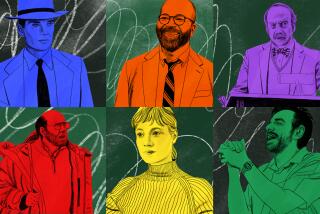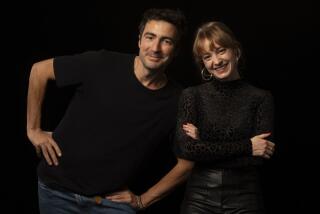Teacher Turned Astronaut Hopes to Fulfill Christa McAuliffe’s Dream
- Share via
SPACE CENTER, Houston — Sometimes when she practices a space shuttle procedure, Barbara Morgan has flashbacks to when she was Christa McAuliffe’s understudy.
The moments of sadness pass quickly. She prefers not to talk about them. “There are also times when I can think of lots of really fun stuff that happened too,” says Morgan, perking up.
McAuliffe, NASA’s effervescent teacher-in-space designee from Concord, N.H., and Morgan, the more subdued runner-up from McCall, Idaho, were almost inseparable in the fall of 1985 as they trained for the flight of space shuttle Challenger.
Wherever McAuliffe went, Morgan went. Whatever McAuliffe learned, Morgan learned. If McAuliffe had become incapacitated, Morgan would have taken her place as the first teacher--indeed, the first private citizen--in space.
No backup was needed. McAuliffe boarded Challenger the icy morning of Jan. 28, 1986, and died along with six others just seconds into the flight.
Morgan watched in horror from the launch site. Seven dear friends dead. And NASA’s teacher-in-space project scrubbed for fear of losing another.
Now, almost 14 years later, Morgan, at 48, is closer than ever to fulfilling McAuliffe’s dream.
She recently completed the required one year of basic astronaut training as NASA’s first educator mission specialist, earning her silver astronaut wings. But there’s a long line of astronauts ahead of her, so she may have to wait at least another year before getting an assignment, and yet another before lifting off. That’s OK with her.
Morgan likens the wait to her days of teaching third grade.
She never obsessed about the last day of classes and, she says, “I’m finding myself in the same situation here as a student. What we’re doing every day is so amazing and hard and exciting and fun that I can’t see past the end of that.”
When they prepared for the Challenger flight, McAuliffe and Morgan received the cursory instruction typically offered to payload specialists--or noncareer astronauts. The focus, Morgan recalls, was on interacting with the shuttle crew and developing lectures for the classroom that McAuliffe planned to deliver from orbit.
The two had joked that this was their real training: Hands off the button. “And I kind of tease now,” Morgan says, “whether she’s listening or not, that, boy, now if I don’t put my hands on the button and do it right, I’m not going anywhere, anyway.”
One of her biggest lessons came from McAuliffe herself. “Christa was great at really focusing on what’s important and then letting go the things that aren’t important, where I would be a little worrywart,” Morgan says. “That’s a lesson I have to keep reminding myself of over and over again.”
After McAuliffe’s death, Morgan traveled the country, speaking in support of the space agency. Despite her urging, NASA refused to resurrect the teacher-in-space program. So she returned to McCall and resumed teaching, and she and her husband, Clay, had two sons. Undeterred, Morgan continued to work part-time with NASA’s education division.
Then, in January 1998, NASA renewed the call for teachers but demanded full-time commitment. If they had a math, science or engineering degree and met all other criteria, they, too, could become astronauts. Not only would they teach from space, they would also perform flight duties.
Of this year’s 3,015 applicants, a couple hundred are teachers, from elementary to college, says Duane Ross, manager of NASA’s astronaut selection office.
Barbara Morgan was named to the astronaut class of ’98 at the same news conference, in January 1998, that announced John Glenn’s return to orbit.
“I don’t see this as an opportunity for me,” Morgan told NASA administrator Daniel S. Goldin then. “This is an opportunity for the whole country, and it’s all about education and how important it is.”
Several months later, the school year over, Morgan and her family moved to Houston, home of the Johnson Space Center. Clay, a novelist, supports his wife’s commitment by being home when their sons, 10 and 12, return from school.
As much as she likes being an astronaut, Morgan misses teaching at McCall Elementary. “It doesn’t make me wish I were doing it again. It makes me know I want to do it again,” she emphasizes.
Morgan regrets she has so little time to keep in touch, but the school keeps up with her. A handmade card is all ready to go, signed by staff and pupils, congratulating Morgan on her silver astronaut wings. (Gold wings come after a spaceflight.)
Letters from teachers around the country are piling up. They write from all over, inspired by Morgan’s tenacity. Some are even encouraged to become astronauts.
Morgan has a degree in human biology and teaching credentials. She is learning all about engineering and shuttle systems and her assigned specialty: stowage and trash, not just for the shuttle but also for the new international space station.
“I’m catching on and understanding it. But I’m not going to fool myself to thinking I know it, because I don’t,” she says. “There are no different expectations. I’m not being singled out as being different, which I really appreciate.”
Even in the dark days after the Challenger tragedy, Morgan held on to her belief that someday she would fly in space.
“I made a commitment a long time ago to this program, and NASA made a commitment a long time ago to this program,” she says, “and it’s satisfying to be able to really follow through.”
More to Read
Sign up for Essential California
The most important California stories and recommendations in your inbox every morning.
You may occasionally receive promotional content from the Los Angeles Times.













